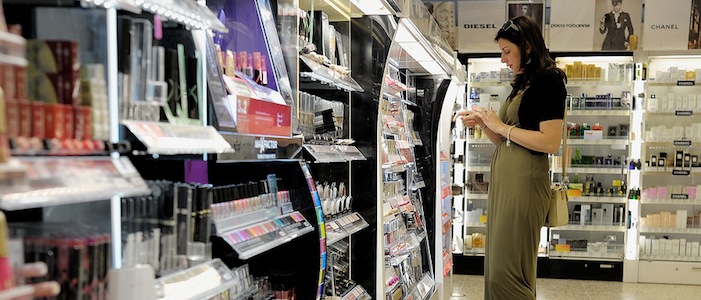They are being heralded as ‘the next big thing’. The technology allows shoppers to be tracked as they shop and for messages and offers to be sent to them, and is being tested extensively by major retailers and manufacturers alike. In-store beacons are touted as a way to massively enhance the shopping experience in bricks and mortar stores. Yet a recent report by OpinionLab suggests that shoppers aren’t convinced. 77% of respondents said that in-store tracking was unacceptable, and 81% said they didn’t trust retailers with their data. Add to that the danger of a high quantity of Beacon messaging feeling very much like spam, what is the future of in-store beacons and how can manufacturers and retailers glean value from this technology?
Why all the hype?
To judge by the noise in the press, in-store beacons are going to change the retail world. Since the launch of Apple’s iBeacon technology, retailers such as Macy’s, Clarks, Tesco, Waitrose, Walmart and Walgreens have all announced tests. Major manufacturers such as Coca-Cola, Pepsi and Mondalez are also experimenting. Why is this technology so exciting?
Massive wins for retailers from in-store beacons
For the retailers, there is lots to get excited about. The technology will allow them to track shoppers as they move around the store, understand where they go and what they buy (by linking the data to loyalty cards) and potentially being able to link on and offline shopping data to really understand shoppers. In addition, by filling their stores with their own Beacons, they go some way to rebuilding the wall that used to ring-fence shopper messaging. Before smartphones retailers could control all of the media and messaging that a shopper received. Mobile changed all that and gave rise to the show-rooming and price comparison phenomena: locking a shopper into a retailer’s app gives back some control. And that audience, of course, is yet another media opportunity to sell to manufacturers eager to thrust their brand under the noses of shoppers.
A distant opportunity for manufacturers?
To date there is less for manufacturers to get excited about. Whilst the promise of being able to target messaging to shoppers right there at the point of purchase is exciting, most forays into the space seem to focus on giving discounts: a very high tech price-off coupon, if you will. But as retailers invest in the technology, manufacturers will, one assumes, be under some pressure to utilize (by which I mean pay for) ‘slots’ on in-store beacons in the same way that they pay for gondolas. If this is not to become just another way of putting cash into retailers’ pockets and eroding brand value and margins, both retailers and manufacturers need to think carefully about how they utilize in-store beacons.
6 Ways to get best value from In-store beacons
Get targeted
The major upside of in-store beacons is the potential to target. If a display of ice-cream pings a message or discount to everyone who passes then the path to spam is spiraling downhill. The opportunity lies in considering the sub-set of shoppers that is important, working out how to identify them, and then tailoring a meaningful message to them. Shopper segmentation and targeting, tuned to data which can be sourced from the smartphone app, will be critical. Get this wrong and apps will be switched off, and the only people left cruising the beacon landscape will be deal hunters.
Recognize the limitations
In-store beacons will only work for some shoppers, on some shopping trips, where the shopper has Bluetooth on, has the app or is prepared to download it, and allows tracking to take place. Interaction is likely therefore to skew towards retail loyalists (who see repeated value in downloading a specific app), and deal hunters, who just revel in the opportunity to get a deal. For the manufacturer, neither group may be your core target.
Focus on the right message
As with all communication, getting the message right is critical. The temptation to tell your entire brand story (after all, it’s interesting to you, right?) must be resisted. Be realistic about how much you can communicate there and then in the store aisle. Focus then on the message that this particular segment of shoppers needs to hear to turn them into buyers.
Focus on shopper value
The big challenge is to give shoppers what they want, rather than sending what we want to give. Early tests suggest that store navigation is appreciated, and that rapid payment systems (which negate the need to queue) are likely to help. By understanding what shoppers want (beyond, hopefully, discounts) shopping experiences can be truly enhanced.
Read data carefully
Whilst it is clear that the value of in-store beacons seem to lie in data, care needs to be taken in understanding what this data means. As with loyalty cards, they only show part of the picture. Many shoppers may not use the technology at all. Those that do may not use it every trip (I often close down apps and switch off Bluetooth on my iPhone to conserve battery life) and of course it only covers the part of their shopping that takes place in those stores. Don’t get me wrong, the data can be valuable, but it needs to be handled with care.
Offer a meaningful deal
Unfortunately, the Groupon generation have come to expect a deal pretty much anywhere, and whilst I’m usually against the current vogue of discounting, shoppers in this case have a point. If they are going to give up their privacy, then they need some reward. The watch-out for manufacturers is to beware that the retailer gets the data, and the manufacturer is left paying for the discount.
Only time will tell whether in-store beacons transform the shopping experience and the fortunes of bricks and mortar retailers, or become just another gimmick that comes and goes. What do you think? I’d love to hear views both for and against – please add comments below.
Image: All rights Mike Anthony





